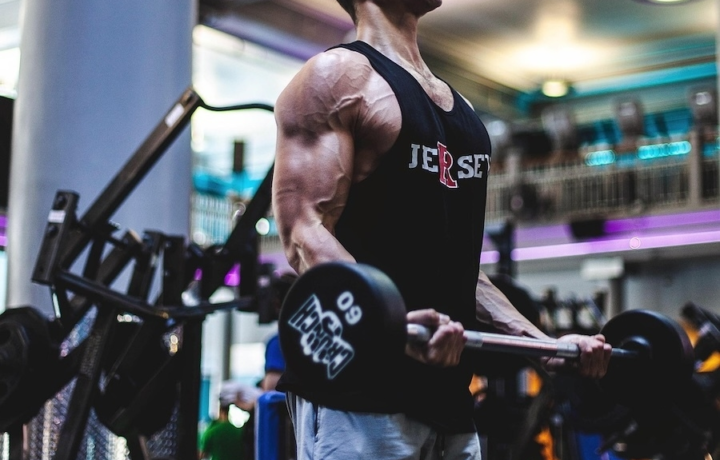Exercise
Dumbbell Single Arm Bent Over Row

Dumbbell Single Arm Bent Over Row
How to Perform
- Stand beside a bench with feet shoulder-width apart and place your right hand and right knee on the bench for support.
- Hold a dumbbell in your left hand with a neutral grip, allowing your arm to hang straight down toward the floor.
- Keep your back flat and parallel to the ground, with your head in a neutral position aligned with your spine.
- Brace your core and pull your shoulder blade down and back before initiating the movement.
- Exhale as you pull the dumbbell up toward your hip, keeping your elbow close to your body and driving your elbow toward the ceiling.
- At the top position, squeeze your back muscles while keeping your torso stable and maintaining a neutral spine.
- Inhale as you slowly lower the dumbbell back to the starting position with control, feeling a stretch in your lat muscle.
- Complete all repetitions on one side before switching to the opposite arm and repeating the movement.
Important information
- Keep your supporting hand and knee firmly planted on the bench to maintain stability throughout the exercise.
- Avoid rotating your torso during the movement; your shoulders should remain parallel to the ground.
- Focus on pulling with your back muscles rather than your arm to maximize lat engagement.
- If you feel strain in your lower back, reduce the weight or check your form to ensure your core is properly braced.

Dumbbell Single Arm Bent Over Row
Exercise Details
Primary Muscles
Muscle Groups
Mechanic
Risk Areas
Built for progress
Take the guesswork out of training
Create personalized AI-powered workout plans that evolve with you. Train smarter, track every rep and keep moving forward, one workout at a time.






The Dumbbell Single Arm Bent Over Row stands as a cornerstone exercise for developing impressive back musculature, particularly targeting the latissimus dorsi (lats) and trapezius (traps) muscles. This intermediate movement delivers exceptional unilateral development, allowing you to identify and correct strength imbalances between your right and left sides while engaging your core in a unique stabilizing challenge.
What makes this exercise particularly valuable is its versatility across training styles. Bodybuilders embrace the single arm row for its ability to create time under tension and achieve that coveted mind-muscle connection, leading to superior muscle hypertrophy in the mid-back region. Meanwhile, HIIT enthusiasts appreciate how quickly it elevates heart rate when performed with moderate weight and higher repetitions within circuit formats.
From a strength perspective, the unilateral nature of this movement builds foundational pulling power that translates to improved performance in deadlifts, pull-ups, and even athletic movements like swimming and climbing. The exercise recruits numerous secondary muscles including the rhomboids, posterior deltoids, biceps, and forearm flexors, making it an efficient use of training time for those seeking maximum results.
The beauty of the single arm row lies in its scalability - beginners can start with lighter weights to master form, while advanced lifters can challenge themselves with heavier dumbbells to push strength boundaries. Many strength coaches consider this movement superior to machine rows because it demands core stability and teaches proper hinge mechanics that protect the lower back during daily activities.
For those dealing with shoulder mobility issues, this exercise offers a friendly alternative to barbell rows since the neutral grip position places less stress on the shoulder joint while still effectively targeting the intended muscle groups. Incorporate this powerful movement into your routine twice weekly to experience noticeable improvements in back thickness, posture, and pulling strength within weeks.
FAQ - Dumbbell Single Arm Bent Over Row
The Dumbbell Single Arm Bent Over Row primarily targets the latissimus dorsi (lats) and trapezius muscles. It also engages secondary muscles including the rhomboids, posterior deltoids, biceps, and forearm flexors while requiring significant core activation for stabilization.
Stand facing the cable machine with the ankle attachment secured, maintain a slight bend in your supporting leg, and keep your core engaged throughout the movement. Focus on driving the movement from your glutes rather than your lower back, and avoid arching or rounding your spine.
Choose a weight that allows you to complete 8-12 reps with perfect form while feeling challenged in the final reps. Beginners should start lighter (10-20 lbs) to master technique, while intermediate lifters typically use 25-45 lbs and advanced lifters may work with 50+ lbs depending on their goals.
For optimal results, incorporate this exercise 1-2 times weekly with at least 48 hours between sessions targeting the same muscle groups. If building back strength is a priority, you can program it as a primary movement on your pulling/back days.
Avoid rounding your lower back, using momentum to swing the weight, rotating your torso excessively, or shrugging your shoulder toward your ear. Also, don't rush the movement—control the dumbbell throughout the entire range of motion for maximum muscle engagement.







